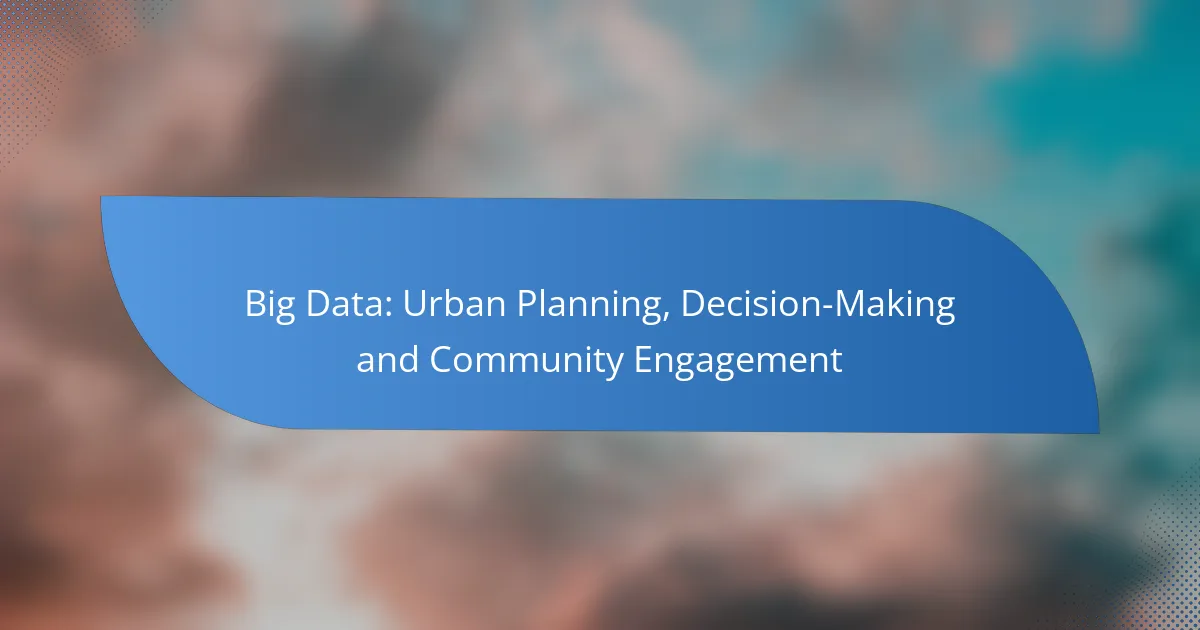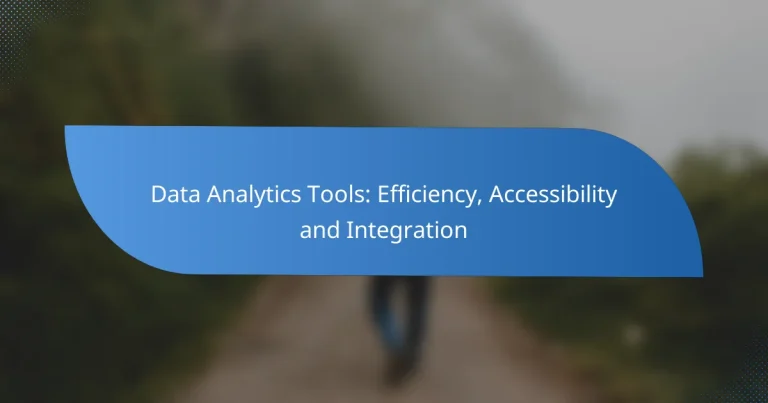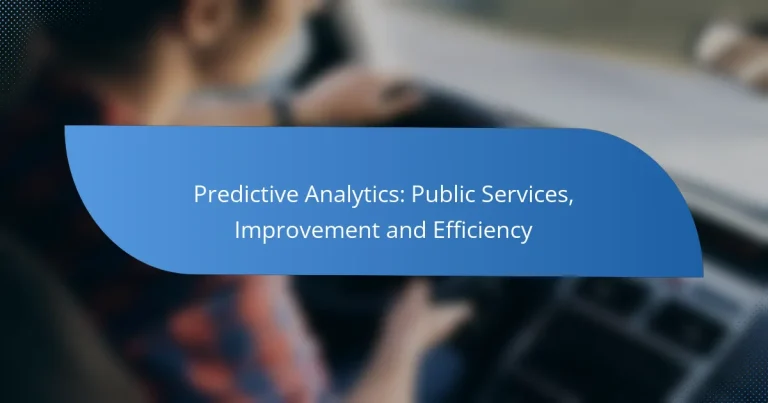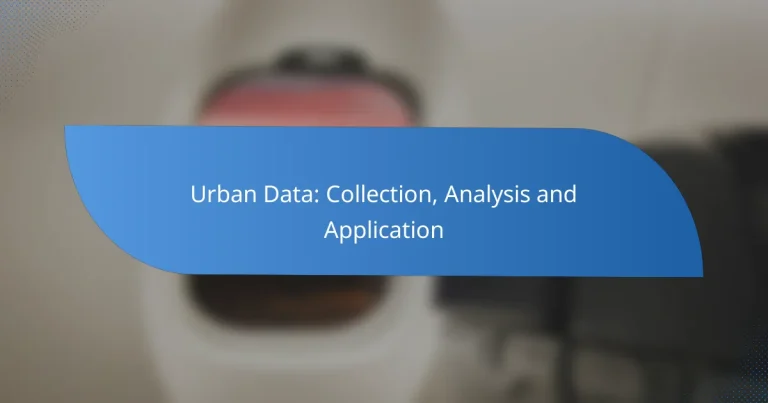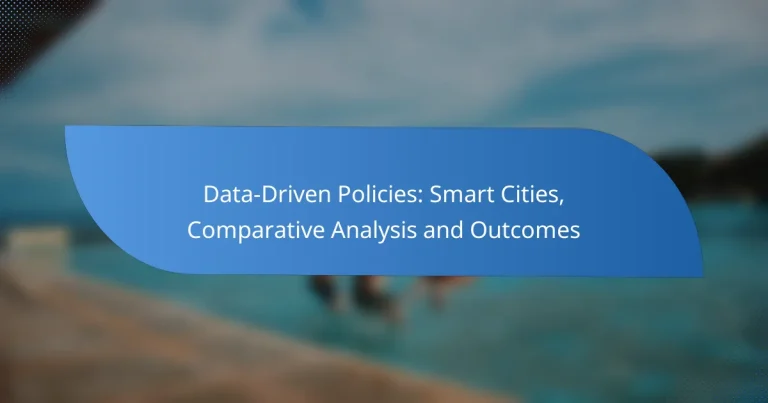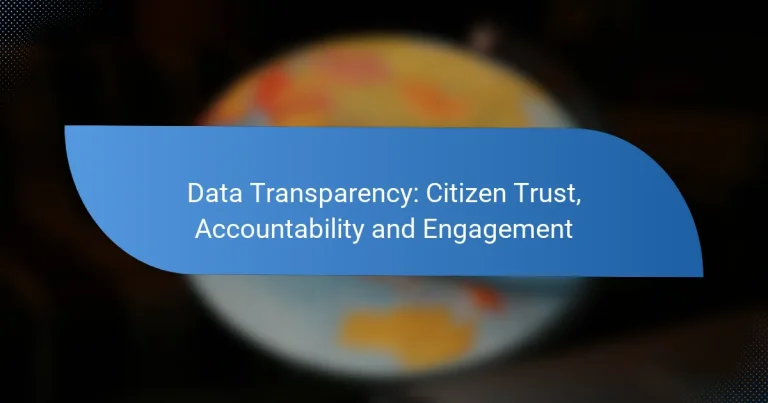Big Data: Urban Planning, Decision-Making and Community Engagement
Big data significantly transforms urban planning by offering valuable insights that enhance decision-making, resource management, and community engagement. By harnessing vast datasets from diverse sources, planners can design more efficient and sustainable urban environments that respond effectively to the needs of their communities.
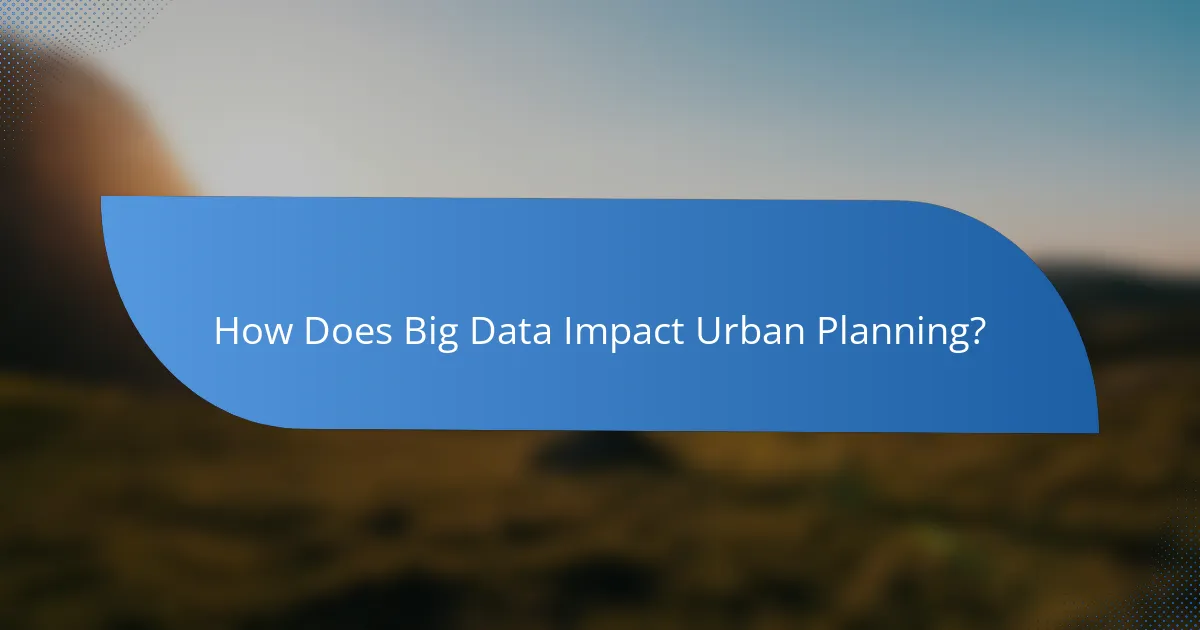
How Does Big Data Impact Urban Planning?
Big data significantly influences urban planning by providing insights that enhance decision-making, resource management, and community engagement. By analyzing vast amounts of data from various sources, planners can create more efficient, sustainable, and responsive urban environments.
Data-driven infrastructure development
Data-driven infrastructure development utilizes real-time data to inform the planning and construction of urban facilities. For example, traffic patterns collected from sensors can guide the placement of new roads or public transport routes, ensuring they meet current and future demand.
Planners can also leverage geographic information systems (GIS) to visualize data trends, helping to identify areas in need of infrastructure upgrades. This approach minimizes waste and maximizes the impact of investments, ultimately leading to smarter cities.
Enhanced resource allocation
Enhanced resource allocation through big data allows city officials to distribute resources more effectively based on actual needs. By analyzing demographic data, usage patterns, and service requests, municipalities can prioritize funding for essential services like waste management, public safety, and emergency response.
For instance, cities can use data to determine which neighborhoods require more frequent garbage collection or additional police presence, ensuring that resources are allocated where they are most needed. This targeted approach can lead to improved community satisfaction and better overall service delivery.
Predictive analytics for zoning
Predictive analytics for zoning employs historical data and trends to forecast future urban development needs. By examining factors such as population growth, economic activity, and land use, planners can make informed decisions about zoning regulations and land allocation.
For example, if data indicates a rising population in a specific area, planners might adjust zoning laws to allow for higher-density housing. This proactive strategy helps prevent housing shortages and supports sustainable urban growth, ultimately benefiting residents and businesses alike.
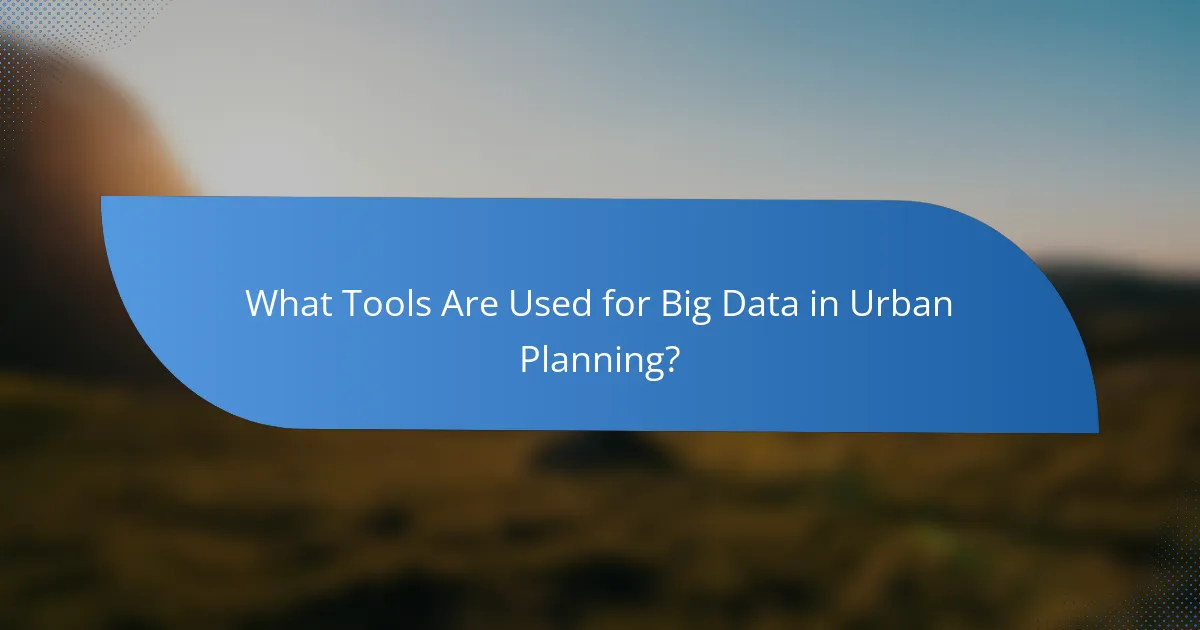
What Tools Are Used for Big Data in Urban Planning?
Big data in urban planning utilizes various tools to analyze spatial information, visualize data trends, and generate predictive insights. These tools help city planners make informed decisions that enhance community engagement and optimize resource allocation.
ArcGIS for spatial analysis
ArcGIS is a powerful tool for spatial analysis, allowing urban planners to visualize and interpret geographic data. It helps in mapping out land use, transportation networks, and environmental factors, enabling planners to identify patterns and relationships within the urban landscape.
When using ArcGIS, consider integrating various data layers such as demographics, infrastructure, and zoning regulations. This multi-layered approach can provide deeper insights into how different factors interact, aiding in more effective planning strategies.
Tableau for data visualization
Tableau excels in transforming complex datasets into interactive visualizations, making it easier for stakeholders to understand urban planning data. With its user-friendly interface, planners can create dashboards that display key metrics and trends, facilitating better communication with the community.
To maximize Tableau’s effectiveness, focus on clear, concise visualizations that highlight critical data points. Avoid cluttering dashboards with excessive information; instead, prioritize the most relevant insights to engage your audience effectively.
IBM Watson for predictive insights
IBM Watson leverages artificial intelligence to provide predictive insights that can guide urban planning decisions. By analyzing historical data and current trends, it can forecast future scenarios, helping planners anticipate challenges and opportunities in urban development.
When implementing IBM Watson, ensure that you have quality data inputs, as the accuracy of predictions relies heavily on data integrity. Regularly update your datasets to reflect changing conditions and improve the reliability of the insights generated.
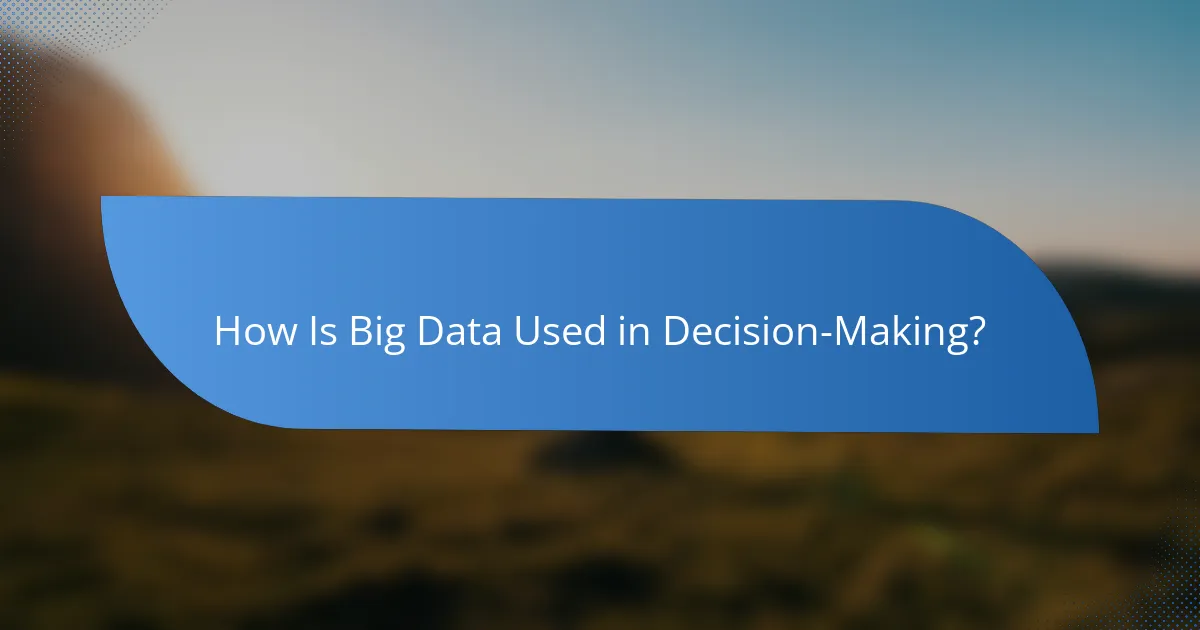
How Is Big Data Used in Decision-Making?
Big data plays a crucial role in decision-making by providing insights derived from vast amounts of information. It enables urban planners and policymakers to make informed choices that address community needs and improve city functionality.
Real-time data for policy-making
Real-time data allows policymakers to respond swiftly to emerging issues, such as traffic congestion or public health crises. By analyzing live data streams from sources like social media, sensors, and public records, decision-makers can adjust policies and resource allocation effectively.
For instance, cities can utilize traffic data to optimize signal timings, reducing congestion and improving air quality. This immediate feedback loop enhances the responsiveness of urban governance.
Scenario modeling for urban growth
Scenario modeling uses big data to simulate various urban growth patterns, helping planners visualize potential outcomes of different strategies. By analyzing historical trends and current data, models can predict how changes in zoning laws or infrastructure investments might affect population density and land use.
Planners can create multiple scenarios, assessing factors such as economic impact, environmental sustainability, and community well-being. This approach enables stakeholders to make more informed decisions about future developments.
Community feedback integration
Integrating community feedback into decision-making processes is essential for creating inclusive urban environments. Big data tools can analyze public sentiment from surveys, social media, and public forums, providing insights into community priorities and concerns.
For example, cities can deploy mobile apps to gather resident opinions on proposed projects, ensuring that decisions reflect the needs and desires of the community. This engagement fosters trust and collaboration between citizens and local authorities.

What Are the Benefits of Big Data in Community Engagement?
Big data enhances community engagement by providing insights that foster informed decision-making and active participation. By analyzing vast amounts of information, local governments and organizations can better understand community needs and preferences, leading to more effective engagement strategies.
Improved public participation
Big data facilitates improved public participation by identifying trends and preferences within the community. For instance, analyzing social media interactions can reveal which topics resonate most with residents, allowing planners to focus discussions on relevant issues. This targeted approach can increase attendance at public meetings and encourage more residents to voice their opinions.
Additionally, tools like online surveys and feedback platforms can be enhanced with data analytics, ensuring that outreach efforts are more effective and inclusive. By making participation easier and more accessible, communities can foster a culture of engagement and collaboration.
Tailored communication strategies
With big data, communication strategies can be customized to meet the diverse needs of community members. By segmenting populations based on demographics or interests, local authorities can craft messages that resonate more deeply with specific groups. For example, younger residents may prefer digital communication, while older populations might respond better to traditional methods.
Moreover, analyzing engagement metrics helps refine these strategies over time. Communities can assess which channels yield the highest response rates and adjust their communication efforts accordingly, ensuring that messages are not only heard but also acted upon.
Data transparency initiatives
Big data supports data transparency initiatives by making information more accessible to the public. When local governments share data related to budgets, projects, and community needs, residents can better understand decision-making processes. This transparency builds trust and encourages civic engagement, as residents feel more informed and empowered to participate.
Implementing open data platforms can further enhance transparency. These platforms allow residents to explore datasets related to urban planning, public services, and community demographics, fostering a more informed citizenry. Ensuring that data is presented in user-friendly formats is essential for maximizing public engagement and understanding.
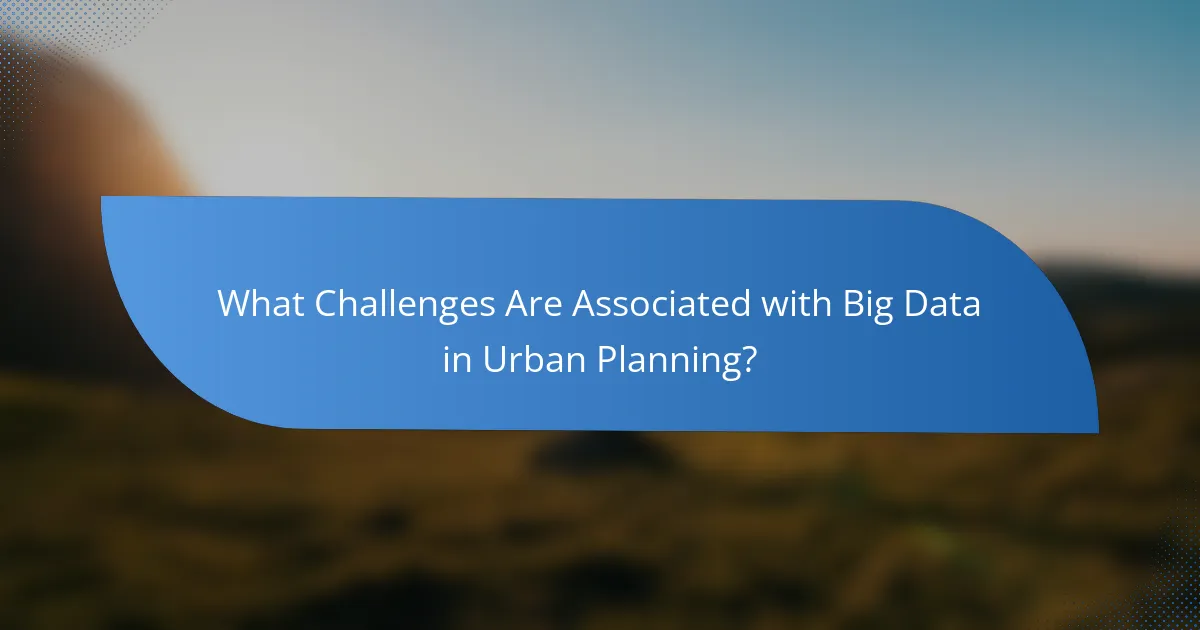
What Challenges Are Associated with Big Data in Urban Planning?
Big data in urban planning presents several challenges, including data privacy concerns, integration with existing systems, and issues related to data quality and accuracy. Addressing these challenges is crucial for effective decision-making and community engagement.
Data privacy concerns
Data privacy is a significant challenge when utilizing big data in urban planning. Collecting and analyzing personal information can lead to potential breaches of privacy and misuse of sensitive data. Urban planners must ensure compliance with regulations such as the General Data Protection Regulation (GDPR) in Europe or similar laws in other regions.
To mitigate privacy risks, planners should anonymize data and implement strong data governance policies. Engaging the community in discussions about data use can also help build trust and transparency.
Integration with existing systems
Integrating big data solutions with existing urban planning systems can be complex and resource-intensive. Many cities rely on legacy systems that may not be compatible with modern data analytics tools, leading to inefficiencies and data silos. A thorough assessment of current infrastructure is essential before implementing new technologies.
To facilitate smoother integration, urban planners should prioritize interoperability and choose platforms that support open data standards. Collaboration between IT departments and urban planners can also streamline the integration process.
Data quality and accuracy issues
Data quality and accuracy are critical for effective urban planning. Poor-quality data can lead to misguided decisions, impacting community development and resource allocation. Urban planners must establish robust data collection methods and validation processes to ensure the reliability of the information used.
Regular audits and updates of data sources can help maintain accuracy. Additionally, utilizing multiple data sources can provide a more comprehensive view, reducing the risk of relying on flawed datasets. Engaging with local communities to gather feedback can also enhance data relevance and precision.
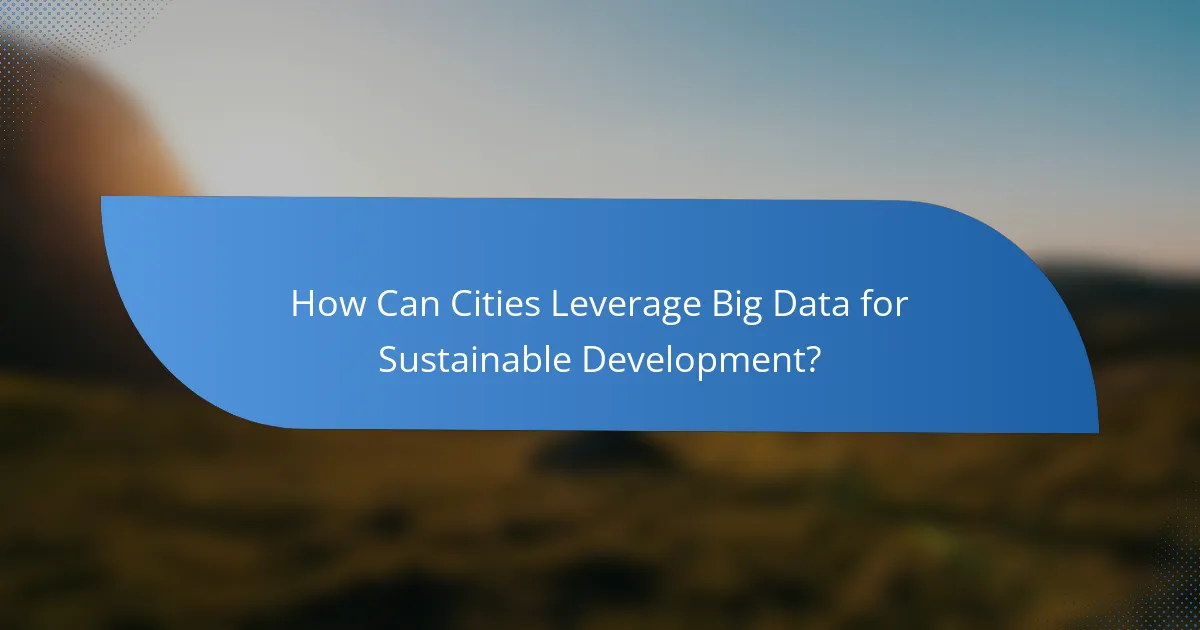
How Can Cities Leverage Big Data for Sustainable Development?
Cities can leverage big data to enhance sustainable development by analyzing vast amounts of information to inform decision-making, optimize resource allocation, and engage communities effectively. This approach enables urban planners to create more efficient, environmentally friendly, and inclusive urban spaces.
Smart city initiatives
Smart city initiatives utilize big data to improve urban living through technology-driven solutions. These projects often involve the integration of sensors, IoT devices, and data analytics to monitor traffic patterns, energy consumption, and public safety. For example, cities like Barcelona and Singapore have implemented smart traffic management systems that adjust signal timings based on real-time traffic data, reducing congestion and emissions.
When developing smart city initiatives, it is crucial to prioritize data privacy and security. Engaging with local communities to understand their needs and concerns can foster trust and ensure that technology serves the public interest. Additionally, cities should consider the long-term sustainability of the technologies they adopt, ensuring they are adaptable and scalable.
Environmental impact assessments
Environmental impact assessments (EIAs) are essential for understanding the potential effects of urban development projects on the environment. Big data can enhance EIAs by providing comprehensive insights into air quality, noise levels, and biodiversity through advanced modeling and simulation techniques. This data-driven approach allows for more informed decision-making and helps identify mitigation strategies early in the planning process.
To conduct effective EIAs, cities should utilize a combination of historical data and predictive analytics. Engaging stakeholders, including community members and environmental experts, is vital to gather diverse perspectives and ensure that assessments are thorough. Additionally, cities should adhere to local regulations and standards, such as the EU’s EIA Directive, to ensure compliance and transparency throughout the assessment process.
